Pterophoridae
| Plume moths | |
|---|---|
 | |
| Emmelina monodactyla (Pterophorinae: Pterophorini) | |
| Scientific classification | |
| Kingdom: | Animalia |
| Phylum: | Arthropoda |
| Class: | Insecta |
| Order: | Lepidoptera |
| Suborder: | Glossata |
| Infraorder: | Heteroneura
|
| Superfamily: | Pterophoroidea |
| Family: | Pterophoridae Zeller, 1841 |
| Type species | |
| Pterophorus pentadactyla Linnaeus, 1758 | |
| Subfamilies | |
|
Agdistinae | |
| Diversity | |
| >90 genera >1,000 species | |
The Pterophoridae or plume moths are a family of Lepidoptera with unusually modified wings. Though they belong to the Apoditrysia like the larger moths and the butterflies, unlike these they are tiny and were formerly included among the assemblage called "Microlepidoptera".
Description and ecology
The forewings of plume moths usually consist of two curved spars with more or less bedraggled bristles trailing behind. This resembles the closely related Alucitidae (many-plumed moths) at first glance, but the latter have a greater number of symmetrical plumes. The hindwings are similarly constructed, but have three spars. A few genera have normal lepidopteran wings.
The usual resting posture is with the wings extended laterally and narrowly rolled up. Often they resemble a piece of dried grass, and may pass unnoticed by potential predators even when resting in exposed situations in daylight. Some species have larvae which are stem- or root-borers while others are leaf-browsers.
Economically important pterophorids include the artichoke plume moth (Platyptilia carduidactyla), an artichoke (Cynara cardunculus) pest in California, while the geranium plume moth (Platyptilia pica)[1] and the snapdragon plume moth (Stenoptilodes antirrhina) can cause damage to the ornamental plants garden geranium (Pelargonium x hortorum) and common snapdragon (Antirrhinum majus), respectively. Other plume moths have been used as biological control agents against invasive plant species – Lantanophaga pusillidactyla against West Indian lantana (Lantana camara), Oidaematophorus beneficus against mistflower (Ageratina riparia), Hellinsia balanotes against groundsel bush (Baccharis halimifolia),[2] and Wheeleria spilodactylus against horehound (Marrubium vulgare).[3]
Taxonomy
The family is divided into the following subfamilies, tribes and genera, some species are also listed:
Subfamily Agdistinae
- Genus Agdistis Hübner, 1825
Subfamily Ochyroticinae
Subfamily Pterophorinae Zeller, 1841
- Tribe Exelastini
- Genus Antarches
- Genus Arcoptilia
- Genus Exelastis
- Genus Fuscoptilia
- Genus Marasmarcha
- Tribe Oidaematophorini
- Genus Adaina
- Genus Crassuncus
- Genus Emmelina Tutt, 1905
- Genus Gypsochares
- Genus Hellinsia Tutt, 1905
- Genus Helpaphorus
- Genus Karachia
- Genus Oidaematophorus Wallengren, 1862
- Genus Paravinculia
- Genus Paulianilus
- Genus Picardia
- Genus Pselnophorus Wallengren, 1881
- Genus Puerphorus
- Genus Setosipennula
- Tribe Oxyptilini
- Genus Apoxyptilus Alipanah et al., 2010
- Genus Buckleria Tutt, 1905
- Genus Capperia
- Genus Crombrugghia
 Pterophoridae. Probable genus Crombrugghia
Pterophoridae. Probable genus Crombrugghia - Genus Dejongia
- Genus Eucapperia
- Genus Geina
- Genus Intercapperia
- Genus Megalorhipida Amsel, 1935
- Genus Oxyptilus
- Genus Paracapperia
- Genus Prichotilus Rose and Pooni, 2003
- Genus Procapperia
- Genus Pseudoxyptilus Alipanah et al., 2010
- Genus Stangeia Tutt, 1905
- Genus Stenodacma
- Genus Tomotilus
- Genus Trichoptilus
- Tribe Platyptilini
- Genus Amblyptilia Hübner, 1825
- Genus Anstenoptilia
- Genus Asiaephorus
- Genus Bigotilia
- Genus Bipunctiphorus
- Genus Buszkoiana
- Genus Cnaemidophorus Wallengren, 1862
- Genus Crocydoscelus
- Genus Fletcherella
- Genus Gillmeria Tutt, 1905
- Genus Inferuncus
- Genus Koremaguia
- Genus Lantanophaga Zimmermann, 1958
- Genus Leesi
- Genus Lioptilodes
- Genus Michaelophorus
- Genus Nippoptilia
- Genus Paraamblyptilia
- Genus Paraplatyptilia
- Genus Platyptilia Hübner, 1825
- Genus Platyptiliodes
- Genus Postplatyptilia
- Genus Quadriptilia
- Genus Sinpunctiptilia
- Genus Sochchora
- Genus Sphenarches
- Genus Stenoptilia Hübner, 1825
- Genus Stenoptilodes Zimmermann, 1958
- Stenoptilodes antirrhina – snapdragon plume moth
- Genus Stockophorus
- Genus Uroloba
- Genus Vietteilus
- Genus Xyroptila
- Tribe Pterophorini
- Genus Calyciphora
- Genus Chocophorus
- Genus Cosmoclostis
- Genus Diacrotricha
- Genus Imbophorus
- Genus Merrifieldia
- Genus Oirata
- Genus Patagonophorus
- Genus Porrittia
- Genus Pterophorus
- Pterophorus pentadactyla – white plume moth
- Genus Septuaginta
- Genus Singularia
- Genus Tabulaephorus
- Genus Wheeleria Tutt, 1905
- Tribe Tetraschalini
- Genus Macrotinactis
- Genus Titanoptilus
- Genus Tetraschalis
- Genus Walsinghamiella
Subfamily Deuterocopinae Gielis, 1993
- Genus Deuterocopus
- Genus Heptaloba
- Genus Hexadactilia
- Genus Leptodeuterocopus
Subfamily Macropiratinae
- Genus Agdistopis
Footnotes
References
- Baker, J. (2002): Factors affecting the establishment of a classical biological control agent, the horehound plume moth (Wheeleria spilodactylus) in South Australia. (A thesis submitted for the degree of Doctor of Philosophy in the Department of Applied and Molecular Ecology, Adelaide University, Australia) PDF fulltext
- Michigan Department of Agriculture (MDA) (1980): Geranium Plume Moth Quarantine. PDF fulltext
- Palmer, W.A & Haseler, W.H. (1992): Foodplant Specificity and Biology of Oidaematophorus balanotes (Pterophoridae): A North American Moth Introduced into Australia for the Control of Baccharis halimifolia (Journal of the Lepidopterists' Society 46(3), 1992: 195-202). PDF fulltext
External links
| Wikimedia Commons has media related to Pterophoridae. |
- British Insects: the Families of Lepidoptera
- http://www.plumemoth.com/ D.L. Matthews, PhD. Florida Museum
- The Plume Moths of Australia



